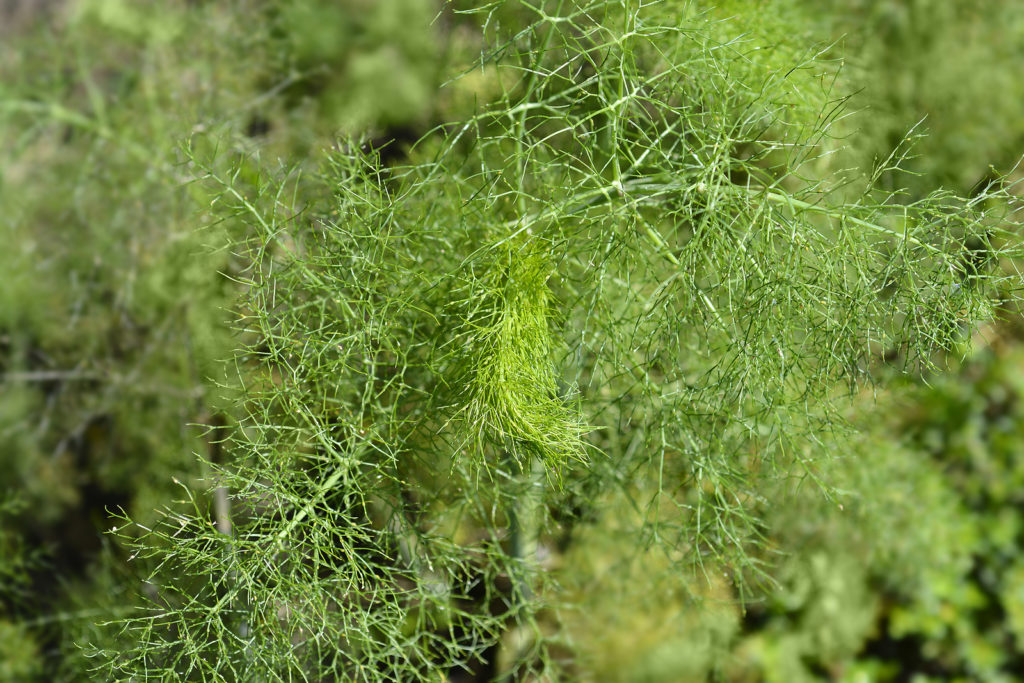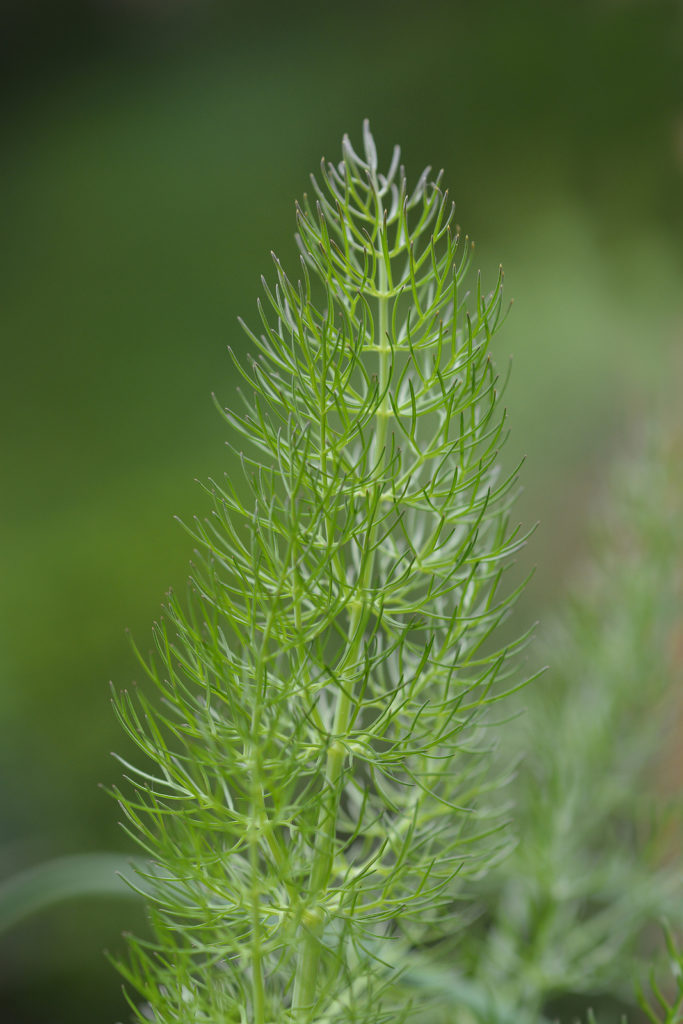Common fennel–also called sweet fennel–can be grown for its leaves, stems, flowers, and seeds. Common fennel is grown as an herb. Its leaves and seeds are used in cooking and baking. Florence fennel—which has a bulbous stem and is a variety of common fennel– is grown for its stem which is eaten as a vegetable. The leaves of common fennel are feathery with a licorice-like flavor. They can be added raw to salads and vegetables. The seeds of common fennel are often added to stuffing and apple pie.
Here is your complete guide to growing sweet
Where to Plant Common Fennel
- Best location: Plant common fennel in full sun.
- Soil preparation: Plant common fennel in well-drained compost-rich soil, however, fennel will grow in all types of soil. Fennel prefers a soil pH of 6.0 to 6.7.

When to Plant Common Fennel
- Seed starting indoors: Common fennel grows a taproot and is best sown in place. If started indoors, plant in individual peat pots so that taproots are not disturbed at transplanting. Sow seed indoors 6 to 8 weeks before the last frost.
- Transplanting to the garden: Set common fennel in the garden after the last frost in spring.
- Outdoor planting time: Sow common fennel seed in spring as early as 2 to 3 weeks before the average last frost date. You can also sow fennel in late summer or early fall for harvest before the first frost. Fennel is half-hardy and will tolerate a light frost. Make succession plantings through late summer for harvest into autumn
How to Plant Common Fennel
- Planting depth: Sow common fennel seed ⅛ to ½ inch deep. Seeds must be covered completely to germinate.
- Spacing: Space common fennel plants 10 to 12 inches apart. Space rows 2 to 3 feet apart. Fennel re-seeds itself readily; plant it where it can grow for several seasons.
- How much to plant: Grow 1 to 2 fennel plants for cooking; grow 4 to 5 plants for preserving.
Common Fennel Companion Planting
- Companion planting: Grow common fennel with sunflowers, calendulas, and nasturtiums to attract butterflies, hummingbirds, and beneficial insects to the garden. Fennel is said to interfere with the growth of beans, tomatoes, and kohlrabi. Do not plant fennel near dill or cilantro; they may cross-pollinate.
Watering and Feeding Common Fennel
- Watering: Give common fennel regular, even watering until it is established. Once established, fennel can be kept on the dry side. Do not overwater fennel.
- Feeding: Side dress common fennel with aged compost at midseason.
Common Fennel Care and Maintenance
- Mulching: Mulch around common fennel in summer to keep roots cool. To make bulb fennel tastier, mulch around the base of the plant to blanch the bulb and make it tender.
- Care: Common fennel can grow 4 to 5 feet tall and may require staking or supports, especially if it is growing in a windy spot. Mound soil up around the base of Florence fennel to blanch the bulb and make it tender.
Container Growing Common Fennel
- Container growing: Common fennel will grow easily in a container. Choose a container at least 12 inches deep; sweet fennel forms a taproot so the container must be deep enough for the root.
- Winter growing: Common fennel can be grown outdoors in mild winter regions.
Common Fennel Pests and Diseases
- Pests: Common fennel is a member of the parsley family. Parsley caterpillars may attack fennel. Remove caterpillars by hand.
- Diseases: Root rot can be a problem if fennel is overwatered or planted in soil that is not well-drained.

How to Harvest Common Fennel
- When to harvest: Common fennel leaves can be snipped for fresh use once plants are 6 inches tall or more and established. Snip leaves before flowering. Common fennel will reach maturity in 60 to 70 days. Harvest the seeds of common fennel after flowering when they turn brown. The thick bulbs at the base of Florence fennel can be eaten like a vegetable as soon as it is large enough to eat; the peak flavor of the bulb comes after flower buds have formed but before blossoms begin to open. Harvest seeds when they turn from yellowish-green to brown. If you do not want seeds, snip away flowers as they form.
- How to harvest: Use snips or scissors to harvest leaves. Cut only the top 2 or 3 inches to ensure regrow.
- xx
Common Fennel in the Kitchen
- Flavor and aroma: Common fennel leaves and seeds have a pleasant licorice-like flavor.
- Leaves: Use fresh leaves in salads and with vegetables, fish, pork, eggs, and rice. Young leaves are milder and sweeter than older fronds.
- Stems: Fresh stalks can be eaten like celery. Use stems in salads or soups. They have a nutty
- Bulbs: Harvest the bulb of Florence fennel while still tender, just before flowering. Eat it raw or cooked as a vegetable. Use bulb fennel in soups and pasta dishes. Slice the bulb thinly and add to salads. The bulb can be cooked in gratins, sautés, and casseroles.
- Flowers: Common fennel flowers are edible and can be added to salads.
- Seeds: Use fennel seeds in home-baked bread, cakes, cookies, sausage, and beverages. Use seeds with cheese spreads, and salad dressings.
Preserving and Storing Common Fennel
- Refrigeration: Keep fresh common fennel in a plastic bag in the refrigerator crisper; use fennel within three days.
- Drying: To collect fennel seeds, cut the seed head and put it in a paper bag in a warm dry place; seeds will drop into the bag as they ripen and dry.
- Freezing: Chop and freeze the leaves in a zippered bag for later use.
- Storing: Dried leaves and seeds can be stored in an airtight jar.
Common Fennel Propagation
- Seed: Grow common fennel from seed that has been stratified (chilled or frozen) for at least 2 weeks. Direct sow seed in the garden any time of the growing season. Seeds sprout in 14 days.
Common Fennel and Other Varieties to Grow
- Common fennel, Foeniculum vulgare
- Florence fennel (Foeniculum vulgare azoricum), also called, finocchio, is grown primarily for its stems and bulbous base which can be used as a vegetable.
- Bronze fennel ( F. v. rubrum) has bronzy purple new growth that lightens to bronze in midsummer. Bronze fennel is grown as an herb and ornamental plant.
Get to Know Common Fennel
- Botanical name and family: Foeniculum vulgare (common fennel); Florence fennel is a cultivar of common fennel; it forms a bulb at the base of the stem; the botanical name of Florence fennel is Foeniculum vulgare azoricum.
- Mediterranean
- Type of plant: Fennel is an herbaceous perennial commonly grown as an annual.
- Growing season: Summer
- Growing zones: Zone 6 to 10
- Hardiness: Fennel is heat tolerant but just slightly cold-tolerant; it will survive a frost but will die to the ground when freezing weather arrives.
- Plant form and size: Fennel grows in clumps with numerous vertical stems from 5 to 7 feet tall; each stem branches near the top and each branch ends with a flat-topped cluster of small yellow flowers; fennel looks very much like dill but is taller and more coarse. Florence fennel is lower growing; it has a large thick stem or leaf base which is bulb-like. The bulb can be eaten as a vegetable and is often called finochio.
- Flowers: Fennel has flat clusters of yellow flowers that grow in clusters or umbles at the ends of the stems above the foliage.
- Bloom time: Fennel blooms from mid-summer to frost.
- Leaves: Fennel has bright yellow-green leaves that are intricately divided, almost threadlike; they resemble dill leaves. Fennel leaves grow on upright, hollow, fleshy stems to about 5 feet tall.
Relared articles:
How to Plant and Grow Florence Fennel
Four Tasty Ways to Cook and Serve Florence Fennel
How to Grow Common Sweet Fennel
Also of interest:



